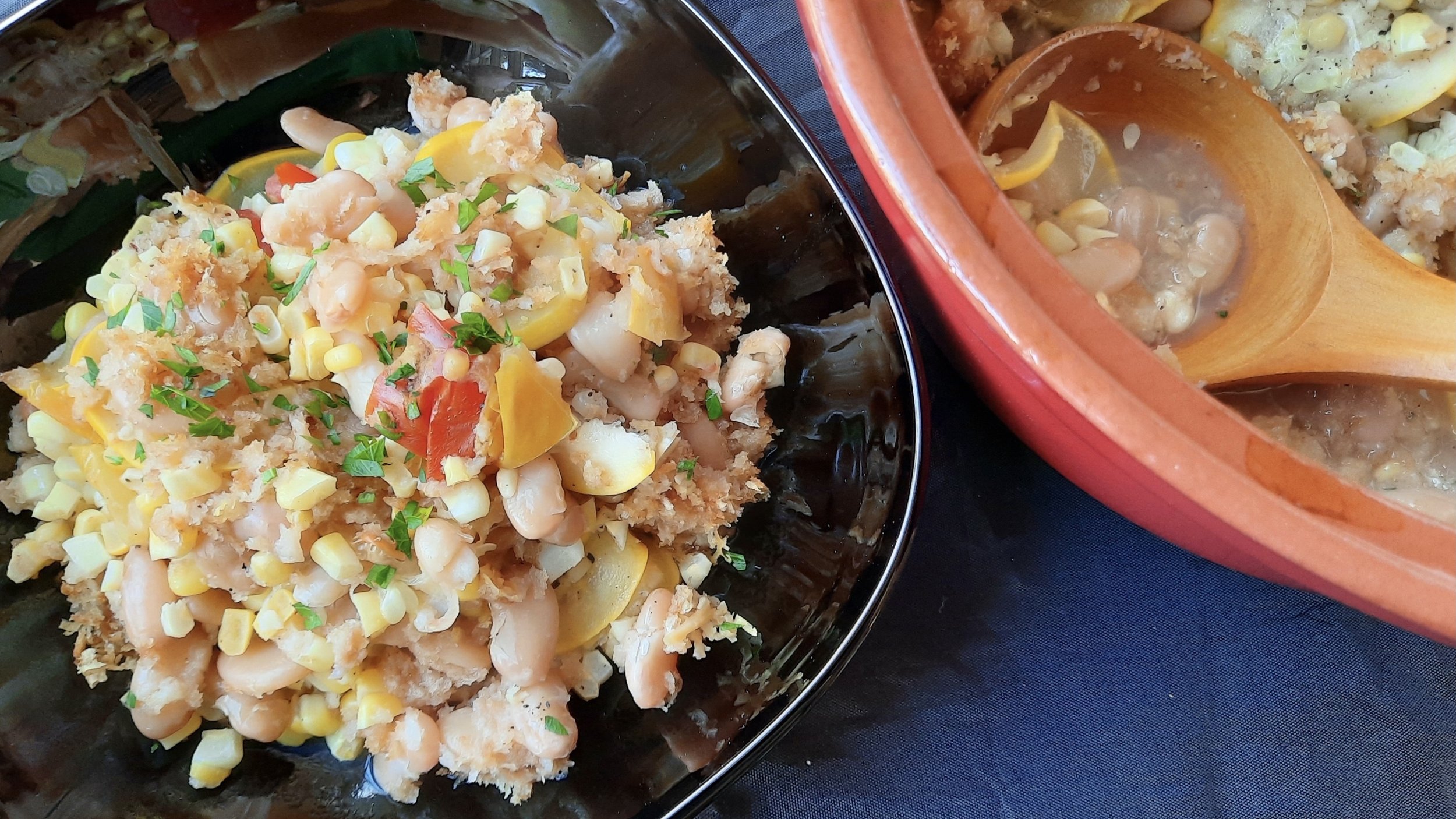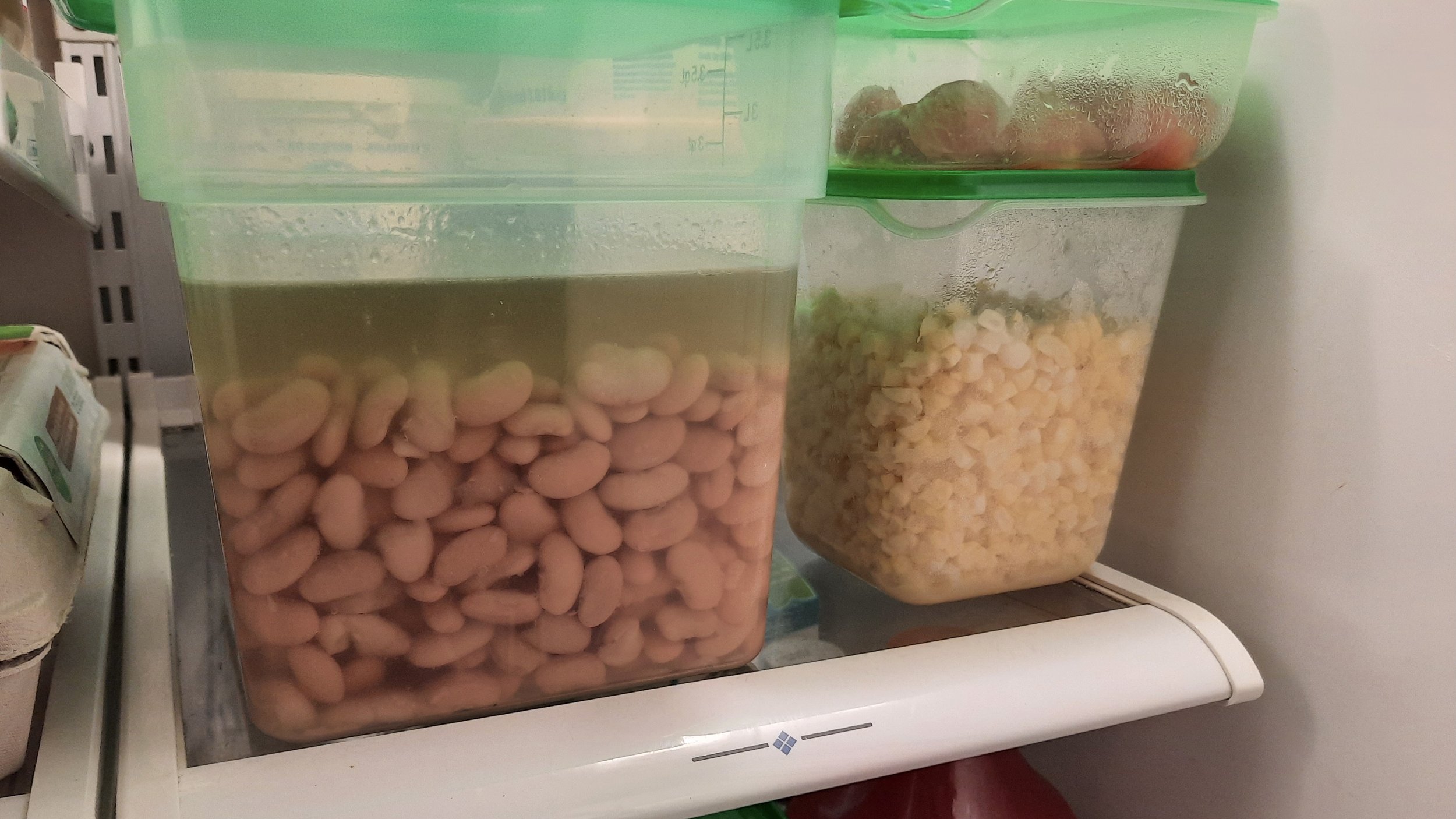TO SOAK BEANS OR NOT
A recipe for Baked Cassoulet Beans with Summer Squash and Corn follows the story on beans below.
Cappucino Purple (background) and Hopi Beans (in hand) from southwestern Colorado.
You might have noticed that some of the longstanding disputes in cooking are dualities, one side pitched as a better choice against one other: unsalted or salted butter, for example, or seasoned cast iron versus non-stick. The Crockpot or the Instant Pot? Russets or waxies? To salt at the beginning of a braise, or towards the end? To bake on a silicone sheet or parchment paper?
Truth be told, all of these are false dilemmas, because appropriate in-between ways also exist, or, in many cases, out-of-the-box third or fourth choices. So, it goes.
However, one debate has persisted as a duality for decades, centuries even, which is whether to soak dried beans—or not, and merely cook them straightaway.
The soaking is overnight or for hours, or some sort of “quick soak” such as to cover them with water, bring them to a boil, turn off the heat and wait an hour.
All the old-time cookbooks in my library (The American Woman’s Cook Book, 1930; Mrs. Rorer’s Philadelphia Cook Book, 1886; The Boston Cooking-School Cook Book, 1896; Joy of Cooking, 1931; even James Beard’s Theory & Practice of Good Cooking, 1977) stipulate an overnight or a 12-hour soak, in oft-italicized “soft” water as finger-waving emphasis. (Some also second what Beard calls “a quick treatment,” which is the boil-and-let-stand option.)
Another dilemma is when to salt the beans, if at all. Generations of grandmothers warn never to salt the beans until the cooking is done, else the tough skins never soften fully. Nowadays, a legion of food scientists admonishes to salt the soaking water before boiling precisely to soften the skins and to guarantee soft, pillowy insides. (I salt as I voted when I lived in Chicago, early and often.)
My favorite bean counter, Steve Sando, owner and farmer at Rancho Gordo in Napa, California (and from whom I purchase all my heirloom dried beans and whose recipe I prepared and tested for this column) has been cooking dried beans for so long that he has taught himself and his pots what he has found best.
Here’s what he says: “My current, and so far fool-proof, technique is: soaked or not, bring the beans and water up to a full boil and keep it there for 15, maybe even 20 minutes. Not a gentle simmer but a rapid boil.
“This initial bullying makes it clear to the beans that you are in charge and there’s no turning back. Then reduce the heat as low as you can take it. If you’re in a hurry, a nice simmer is fine. If you’re cooking for pleasure, the gentlest of simmers is best. Low and slow and loaded with love.”
As for the melodious-minded among us when eating the “musical fruit”? It’s not necessary, as the food scientist Harold McGee sagely writes, to toss out or change any soaking water. “This does leach out the water-soluble oligosaccharides,” he writes, “but it also leaches out significant quantities of water-soluble vitamins, minerals, simple-sugars, and seed-coat pigments; that is, nutrients, flavor, color, and antioxidants. That’s a high price to pay.”
Pellegrino Artusi has ancient advice for the sonorous in his 1891 “Science in the Kitchen and the Art of Eating Well,” Italy’s most significant cookbook of modern times (and the first to be written completely in Italian).
His is a masterful example of Italian diplomacy and discretion: “Beans take some time to leave the body, quelling hunger pangs for a good while. But . . . and even here there is a but, as there so often is in the matters of this world—and I think you get my point. For partial protection, choose thin-shelled beans, or pass them through a sieve.”
Baked Cassoulet Beans with Summer Squash and Corn
Baked Cassoulet Beans with Summer Squash and Corn
From ranchogordo.com; prepared by Bill St. John. Makes 1 gratin dish; serves 4-6. To be vegetarian, omit optional pancetta or bacon from the original. The bean recommendations are from the recipe’s author; you may use any medium to large dried white bean of your choice. The cooking time is adjusted for Colorado’s elevation.
Ingredients
2 tablespoons butter or olive oil, plus more for topping
1 cup fresh breadcrumbs (crusty bread torn into small chunks or cut into cubes)
1 large tomato, sliced, plus 1 cup cherry tomatoes
1/2 pound summer squash, very thinly sliced
2 ears of corn, kernels removed
2 cloves garlic, minced
1 teaspoon lemon zest, plus more for finishing
Salt and freshly ground pepper
3-4 cups cooked Rancho Gordo Cassoulet beans, Ayocote Blanco, Royal Corona, or Flageolet drained, some cooking liquid reserved
Grated pecorino or Parmigiano-Reggiano cheese
Minced fresh mint or basil
Directions
Preheat the oven to 350 degrees. Lightly grease an oven-proof gratin dish. In a small skillet over medium-high heat, melt the butter. Add breadcrumbs and stir, frying until lightly golden. Set aside.
Arrange the tomato slices so they cover the bottom of the dish. Add a layer of squash slices, then top with corn kernels and cherry tomatoes. Save about one-fourth of the squash, corn and cherry tomatoes for the top layer. Sprinkle with the minced garlic, lemon zest, and salt and pepper to taste. Add a layer of beans on top of the vegetables. Pour about 1/4 cup of bean broth over the beans (just enough to wet them). Over the beans, add another layer of squash, corn, and cherry tomatoes. Top with the breadcrumbs. Drizzle with olive oil or, if you prefer, dot with butter.
Bake for about 30-45 minutes, until the breadcrumbs are golden and the squash is tender. Before serving, drizzle with a bit more olive oil and dust with a generous amount of cheese, fresh herbs and more lemon zest.
Always refrigerate and store cooked dried beans in their cooking water, not drained.


